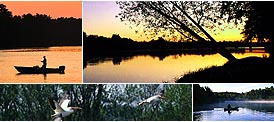


Wildlife Information
Alligators
Black Bear
Whooping Crane
Bald Eagle
Manatee
Florida Panther
Brown Pelican
Florida Wildlife - Brown Pelican
"A wonderful bird is the pelican, his bill can hold more than his belly can...." So begins a well known limerick by Dixon Lanier Merritt that is not far from the truth. The pouch suspended from the lower half of the pelican's long, straight bill really can hold up to three times more than the stomach.
In addition to being used as a dipnet, the pouch holds the pelican's catch of fish until the accompanying water (as much as 3 gallons) is squeezed out. During this time, laughing gulls often hover above pelicans, or even sit on their bills, ready to steal a fish or two. Once the water is out, the pelican then swallows the fish and carries them in its esophagus. The pouch also serves as a cooling mechanism in hot weather, and as a feeding trough for young pelicans. The brown pelican, also called American brown pelican or common pelican, inhabits the Atlantic, Pacific, and Gulf Coasts of North and South America. On the Atlantic Coast, they can be found from Virginia south to the mouth of the Amazon River in Brazil; on the Pacific, they range from central California to south-central Chile and the Galapagos Islands; and on the Gulf of Mexico, they are found in Alabama, Louisiana, and Texas. They are rarely seen either inland or far out at sea. At 42 to 54 inches long, weighing 8 to 10 pounds, and with a 6 1/2- to 7 1/2-foot wingspan, brown pelicans are the smallest members of the pelican family (there are seven species of pelican worldwide). They can be identified by their chestnut-and-white necks; white heads with pale yellow crowns; brown-streaked back, rump, and tail; blackish-brown belly; grayish bill and pouch; and black legs and feet. Brown pelicans are strong swimmers; young ones barely able to fly have been timed swimming at 3 m.p.h. They are rather clumsy on land, and fly with their necks folded, heads resting on their backs, using slow, powerful wingbeats. Pelicans are social and gregarious. Males and females, juveniles and adults, congregate in large flocks for much of the year. Pelicans are primarily fish eaters, and require up to 4 pounds of fish a day. Their diet consists mainly of "rough" fish -- species considered unimportant commercially. This includes menhaden, herring, sheepshead, pigfish, mullet, grass minnows, top minnows, and silversides. Brown pelicans have also been known to eat some crustaceans, usually prawns. Brown pelicans have extremely keen eyesight. As they fly over the ocean, sometimes at heights of 60 to 70 feet, they can spot a school of small fish, or even a single fish. Diving steeply into the water, they may submerge completely or only partly depending on the height of the dive, and come up with a mouthful of fish. Air sacs beneath the pelican's skin cushion the impact and help it surface. Brown pelicans nest in large colonies on the ground, in bushes, or in the tops of trees. On the ground, a nest may be a shallow depression lined with a few feathers and a rim of soil built up 4 to 10 inches above ground, or it may be a large mound of soil and debris with a cavity in the top. A tree-top nest is built of reeds, grass, and straw heaped on a mound of sticks interwoven with the supporting tree branches. In most of the pelican's U.S. nesting range (South Carolina to Florida in the East; Southern California in the West; and Alabama, Louisiana, and Texas on the Gulf), peak egg-laying occurs in March and April. Two or three chalky white eggs hatch in approximately 1 month. Like many birds, newly hatched pelicans are blind, featherless, and altricial -- completely dependent upon their parents. They soon develop a soft, silky down, followed by feathers. Average age at first flight is 75 days. Brown pelicans have few natural enemies. Although ground nests are sometimes destroyed by hurricanes, flooding, or other natural disasters, the biggest threat to pelican survival comes from man. In the late 19th and early 20th centuries, pelicans were hunted for their feathers, which adorned women's clothing, particularly hats. During the food shortages following World War I, fishermen claimed pelicans were decimating the commercial fishery resource and slaughtered them by the thousands. The nests were also frequently raided for eggs. With the advent and widespread use of pesticides such as DDT in the 1940s, pelican populations plummeted due to lack of breeding success. DDT, picked up by pelicans eating contaminated fish, caused the birds to lay eggs with shells so thin they broke during incubation. Several efforts in the early part of the century were meant to curb the decline of brown pelicans. In 1903, President Theodore Roosevelt designated Florida's Pelican Island as the first national wildlife refuge, a move that helped reduce the threat of plume hunters. Passage of the Migratory Bird Treaty Act in 1918 gave protection to pelicans and other birds and helped curb illegal killing. Studies proving the pelicans were not harming commercial fisheries helped to stop the wholesale slaughter of pelicans by fishermen. In 1970, the U.S. Fish and Wildlife Service listed the brown pelican as an endangered species (under a law that preceded the Endangered Species Act of 1973), meaning it was considered in danger of extinction through all or a significant portion of its range. In 1972, the Environmental Protection Agency banned the use of DDT in the U.S. and placed heavy restrictions on the use of other pesticides. Since then, there has been a decrease in the level of chemical contaminants in pelican eggs, and a corresponding increase in nesting success. The brown pelican was the first species to so recover from the effects of pesticides. In 1985, brown pelican populations on the Atlantic Coast of the U.S. (including all of Florida and Alabama), had recovered to the point that the species could be removed from the Endangered Species List in that part of its range. The U.S. Gulf Coast population, which is still considered endangered, was recently estimated at nearly 6,000 breeding pairs. The brown pelican is also endangered in the Pacific Coast portion of its range, and in Central and South America. The southern California population of brown pelicans today is estimated at 4,500 to 5,000 breeding pairs.
Information provided by:
Fish and Wildlife Service
















